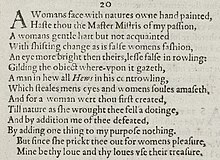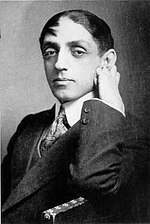Homoerotic poetry
Homoerotic poetry is a genre of poetry implicitly dealing with same-sex romantic or sexual interaction. The male-male erotic tradition encompasses poems by major poets such as Pindar, Theognis of Megara, Anacreon, Catullus, Virgil, Martial, Abu Nuwas, Michelangelo, Walt Whitman, Federico García Lorca, W. H. Auden, Fernando Pessoa and Allen Ginsberg. In the female-female tradition, authors may include those such as Sappho, "Michael Field", "Marie-Madeleine" and Maureen Duffy. Other poets wrote poems and letters with homoerotic overtones toward individuals, such as Emily Dickinson to her sister-in-law Susan Huntington Gilbert.
English poetry

The most prominent example in the English language and in the Western canon is that of Sonnet 20 by William Shakespeare. Though some critics have made efforts to preserve Shakespeare's literary credibility by claiming his work to be non-erotic in nature, no critic has disputed that the majority of Shakespeare's sonnets concern explicitly male-male love poetry. The only other Renaissance artist writing in English to do this was the poet Richard Barnfield, who, in The Affectionate Shepherd and Cynthia, wrote homoerotic poetry. Barnfield's poems, furthermore, are now widely accepted as a major influence upon Shakespeare's.[1]
The Uranian poets and prose writers, who sang the praises of the love between men and boys and in doing so often appealed to Ancient Greece, formed a rather cohesive group with a well-expressed philosophy.[2] Though often anonymously or pseudonymously published or privately circulated, Uranian poetry flourished as a subculture in England in the latter half of the 19th century and the first decades of the 20th century.
During the 19th century the British gay poet Digby Mackworth Dolben was little known; however, in the last decade Lord Alfred Douglas produced a major volume of Dolben's homoerotic poems (1896) published in Paris, written in both English and French translations after the trial of Oscar Wilde for homosexual offences brought about largely by Wilde's love for Douglas. Wilde in De Profundis, a poem about his prison experiences which broke him and led to his death in 1900 in Paris, produced an enduring poem. At the same time A. E. Housman gave voice to gay feelings of fear and guilt in a still-criminalized situation in his A Shropshire Lad (1896). In the twentieth century Noël Coward wrote witty gay poems while the magician Aleister Crowley wrote works in English.[citation needed]
In the twentieth century, W. H. Auden and Allen Ginsberg became well known as poets. In Great Britain the pederast Ralph Chubb lived in poverty and produced his own books in limited editions made from illustrated engravings (similar to methods employed by William Blake), which he then erased.[citation needed]
The British savant Anthony Reid created the largest male homosexual anthology of poems: The Eternal Flame (2 volumes, 1992–2002) which he worked on for nearly fifty years; publication of the second volume was held up by the publisher going bankrupt. The Canadian gay poet Ian Young produced the first major bibliography with his works The Male Homosexual in Literature (2 editions, the second being expanded). The Australian gay poet Paul Knobel's CD-ROM 'An Encyclopedia of Male Homosexual Poetry and its Reception History' (2002) is the largest survey of the subject and comes to one million words with overviews covering over 250 languages and language groups. He has also published A World Overview of Male Homosexual Poetry (2005). Gregory Woods has produced other studies, including a history of gay literature with some reference to poetry.[citation needed]
The period since gay liberation (from 1968) has produced dozens of gay poetry anthologies (e.g. 2 edited by Ian Young alone and others by Winston Leyland producer of the gay lib periodical Gay Sunshine, which included poetry); this has mainly been the result of the increasing decriminalisation of gay sex in the Anglo world (male homosexual acts were decriminalized in France in the late 18th century and in Italy in the late 19th). Notable United States gay poets include Dennis Cooper, Gavin Dillard, John Gill, Dennis Kelly, Tom Meyer, Paul Monette, Harold Norse and Jonathan Williams. Rob Jacques has written about the relationship between love and violence in the military.[3] James S. Holmes was a leather poet who emigrated to Amsterdam. Daryl Hine from Canada and David Herkt and Paul Knobel from Australia have written fine gay poems. New Zealand has a vibrant gay culture and has produced some gay poets. The Canadian gay poet Edward A. Lacey was run over in the street while drunk in Bangkok; repatriated to Canada, he remained bedridden until his death. His complete poems were only published in the early 21st century. The British poet Thom Gunn lived in the United States and wrote a notable volume inspired by AIDS (which has produced several anthologies).[citation needed]
European poetry

The first modern European gay anthology was Lieblingminne und Freundesliebe in der Weltliteratur compiled by Elisar von Kupffer (1900) in German; it was followed by the poetry and prose anthology Iolaus compiled by the homosexual British socialist Edward Carpenter, which has remained in print almost continuously until today. The 1978 anthology French gay anthology with much poetry and excellent illustrations, L'Amour bleu (French for "blue love", that is, forbidden love) has been translated into German and English and remains in print.[citation needed]
Italian has Michelangelo, the Renaissance painter and sculptor, who wrote homosexual love sonnets while Sandro Penna and Dario Bellezza are twentieth century poets. The Venetian gay poet Mario Stefani died in still unexplained circumstances in the early 21st century. Renzo Paris is a notable contemporary poet.[citation needed]
In French there were Rimbaud and Verlaine, who were lovers; some of Verlaine's poems published in the early 1890s were the first open modern French gay poems and influenced Oscar Wilde. Jean Cocteau wrote in the twentieth century where Jean Genet also wrote some gay poems.[citation needed]
In German Adolf Brand wrote gay poetry in the early part of the twentieth century as well as producing the major gay periodical Der Eigene (The Special; 1898–1931), which published gay poetry. The Swiss gay magazine Der Kreis (The circle) carried the flame of gay poetry in the Second World War when the Nazi regime in Germany imprisoned many homosexuals, leading to their deaths. Nils Hallbeck was a Swedish gay poet and in the opinion of Anthony Reid, his English translator, one of the finest gay poets ever. Danish and Dutch have also produced fine gay poets. Gertrud von Puttkamer wrote lesbian-themed poetry in the early to mid 1900s.[citation needed]
Spain produced García Lorca, who was shot in the Spanish Civil War; Lorca and others appear in the anthology Amores iguales (2002) by Antonio de Villena. [4] Antonio Botto is the best known Portuguese poet to write open gay poems; he later lived in Brazil where he died. In Brazil, a gay anthology was produced in 1978 called Poemas do amor mandate (Poems of doomed love).[citation needed]
Hispano-Arabic
It started to gain importance in the beginning of the 9th century, during the reign of Abderraman II.[5]
The fall of the Caliphate of Córdoba in the 11th century and the subsequent rule of the Almoravids—as well as the division into the Taifa kingdoms—decentralized the culture throughout al-Andalus. This produced producing an era of splendor in poetry.[6]
The Almohad invasion brought the emergence of all kinds of new literary courts in the centuries 12th and 13th. The greater female autonomy in this North African ethnic group led to the appearance of a greater number of female poets as well—some of whom also created poems that sang of feminine beauty.[7]
Baltic and middle eastern

Russian has Mikhail Kuzmin and Gennady Trifonov (who was imprisoned for writing homosexual poems which were not published at the time). Valery Pereleshin lived in exile in Brazil where he produced a significant body of gay poetry. Poland had gay poets in the early part of the twentieth century and has an increasingly open gay culture. Brane Mozetic writes in Slovene.[citation needed]
Turkey has a huge gay poetry heritage as does medieval Hebrew. Hebrew gay poetry has been discussed by Norman Roth, Jefim Schirmann and Dan Pagis and dates from the Middle Ages in Spain. C. M. Naim surveyed gay poetry in an article in Studies in the Urdu ghazal and Prose Fiction (1979) and Ralph Russell has dealt with the subject in various books.[citation needed]
See also
Further reading
- Kronenberg, Simeon (October 1, 2015). "Love in Contemporary American Gay Male Poetry in the Works of Richard Siken, Eduardo C Corral and Jericho Brown". Cordite Poetry Review. Retrieved July 9, 2023.
- Knobel, Paul (2005). "English Homosexual Poetry - An Overview". An Encyclopedia of Male Homosexual Poetry and its Reception History. Archived from the original on May 2, 2010.
- Reid, Anthony (2002). The Eternal Flame: A World Anthology of Homosexual Verse c.2000 B.C. to c.2000 A.D. Vol. 2. Asphodel. ISBN 9781893450141.
- Reid, Anthony. The Eternal Flame: A World Anthology of Homosexual Verse c.2000 B.C. to c.2000 A.D. Vol. 1. OCLC 33014635.
- Woods, Gregory (1998). A History of Gay Literature: The Male Tradition. Yale University Press. ISBN 0300080883.
- Woods, Gregory (1987). Articulate Flesh: Male Homo-eroticism and Modern Poetry. Yale University Press. ISBN 9780300047523. JSTOR j.ctt1dr37w3.
- Young, Ian (1982). The Male Homosexual in Literature (second ed.). ISBN 978-0810815292.
- Gerevich, András; Lane, Ryan (August 4, 2023). "András Gerevich: Queer Erasure". Hungarian Literature Online. Archived from the original on August 6, 2023. Retrieved August 5, 2023.
This article by András Gerevich was first published in Hungarian in Magyar Narancs. The English translation is by Ryan Lane.
- Kassai, Zsigmond (June 30, 2023). "Queer Hungarian Literature: On a Path Out of Isolation". Hungarian Literature Online. Archived from the original on July 5, 2023. Retrieved July 6, 2023.
References
- ^ Daugherty, Leo (2001). "The Question of Topical Allusion in Richard Barnfield's Pastoral Verse". In Boris, Kenneth; Klawitter, George (eds.). The Affectionate Shepherd: Celebrating Richard Barnfield. Selinsgrove, Pennsylvania: Susquehanna University Press. p. 45.
- ^ Dynes, Wayne R., ed. (2016). The Encyclopedia of Homosexuality. Volume II. Abingdon and New York: Routledge. p. 1353.
- ^ Jacques, Rob (March 14, 2017). War Poet. Sibling Rivalry Press, LLC. ISBN 978-1-943977-29-1.
- ^ For South American poets, see the bilingual anthology Now the Volcano (San Francisco, 1979).
- ^ Eisenberg, Daniel (1996). "El Buen Amor heterosexual de Juan Ruiz". Los territorios literarios de la historia del placer (in Spanish). Huerga Y Fierro Editores. pp. 59–60. ISBN 9788489678606.
- ^ Rubiera Mata (1992). "IV. La poesía árabe clásica: el esplendor (Siglo XI)". Cervantes Virtual (in Spanish).
- ^ Rubiera Mata (1992). "V. La poesía árabe clásica en al-Andalus III: el dorado crepúsculo (Siglos XII-XIII)". Cervantes Virtual (in Spanish).


